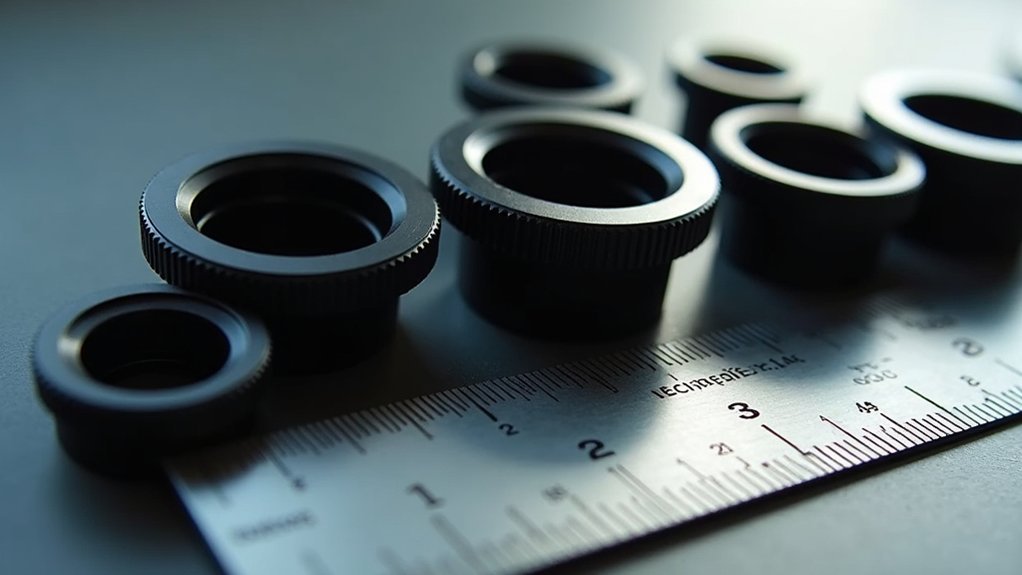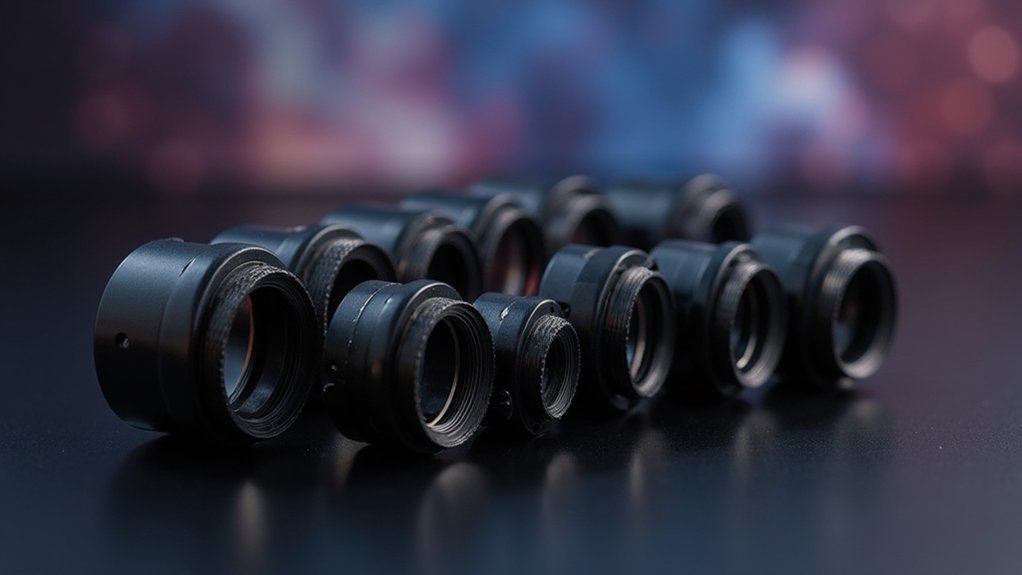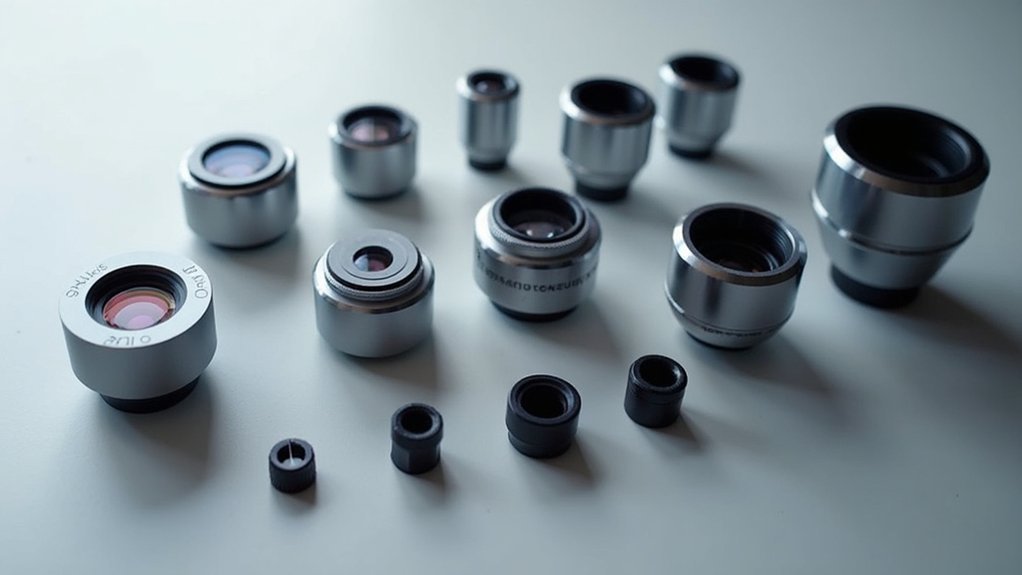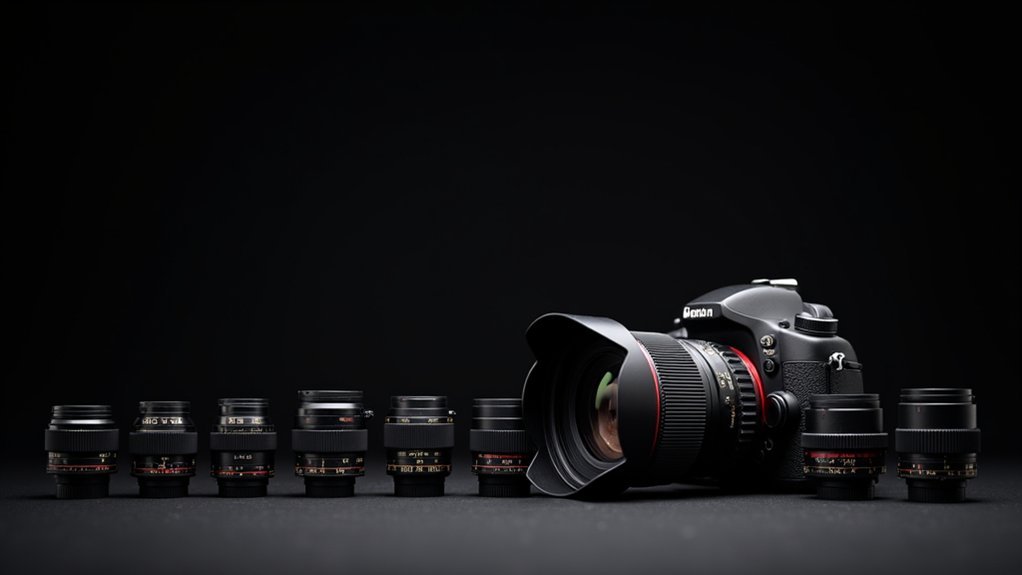Eyepiece adapters for telescope photography commonly come in 1.25-inch (M28.5×0.6 thread) and 2-inch (M48x0.75 thread) sizes. You’ll need a T-Ring specific to your camera brand and a T-Adapter to connect your DSLR. For smartphone photography, dedicated smartphone adapters are available. When choosing adapters, consider your telescope’s focuser diameter and whether you’ll use prime focus or eyepiece projection techniques. The right adapter combination can dramatically improve your astrophotography results.
Understanding Standard Eyepiece Adapter Sizes

When you’re exploring the universe through your telescope, understanding eyepiece adapter sizes becomes essential for ideal viewing experiences.
Most modern telescopes accommodate two standard eyepiece adapter sizes: 1.25 inches and 2 inches.
The 1.25-inch eyepiece barrels (M28.5×0.6 thread) are most common, with a focal length limit of approximately 32mm.
The 1.25-inch standard dominates the market, offering excellent viewing experiences within the 32mm focal length range.
If you’re seeking wider fields of view, 2-inch eyepieces (M48x0.75 thread) allow focal lengths up to 55mm, delivering brighter images ideal for astrophotography.
Less common specialty sizes include 0.965, 2.7, and 3 inches, which might require adapters for your telescope.
Before purchasing new eyepieces, check your telescope’s specifications to verify compatibility with your existing setup.
Using the correct standard eyepiece adapter sizes will maximize your telescope’s performance and enhance your stargazing experience.
The 1.25-Inch Adapter: Specifications and Compatibility
The 1.25-inch adapter features standard T-threads (M42x0.75) that connect to your camera via a T2 ring, making it compatible with most reflector and refractor telescopes.
You’ll need to decide between prime focus photography, where light travels directly from the telescope to your camera sensor, or projection photography using an eyepiece for additional magnification.
The adapter’s dual design supports both methods, allowing you to switch between prime focus and eyepiece projection without changing your entire setup.
Adapter Thread Specifications
Standard across most astronomical equipment, the 1.25-inch adapter incorporates the precise M28.5×0.6 thread specification that guarantees universal compatibility with 1.25-inch eyepieces and filters. You’ll find this adapter thread specification particularly useful when switching between different eyepiece types or adding specialized filters to enhance your viewing experience.
| Thread Type | Compatible With | Maximum Diameter |
|---|---|---|
| M28.5×0.6 | Standard 1.25″ eyepieces | 38mm |
| M28.5×0.6 | Light pollution filters | 1.25″ |
| M28.5×0.6 | Color/specialty filters | 1.25″ |
The dual-purpose design offers flexibility whether you’re using direct telescope connection or eyepiece projection. This versatility guarantees you’ll be able to connect to most reflector and refractor telescopes with 1.25-inch holders while maintaining the ability to use filters for astrophotography enhancements.
Prime Focus vs. Projection
Understanding the difference between prime focus and projection methods opens up new possibilities for your astrophotography efforts. The 1.25-inch adapter supports both techniques with its dual design.
In prime focus photography, you’ll connect your Canon EOS or Nikon SLR directly to the telescope using the focal adapter portion, fundamentally making your telescope the camera lens. This delivers a wide field of view with minimal magnification.
For projection photography, you’ll insert an eyepiece into the adapter’s projection component, which increases magnification. You can fine-tune this magnification by adjusting the eyepiece position.
Many photographers also incorporate a Barlow lens for additional magnification and improved focusing capability.
Working With 2-Inch Eyepiece Adapters

You’ll find 2-inch eyepiece adapters offer expanded compatibility with larger focal length eyepieces up to 55mm, providing enhanced views for deep sky observations.
These adapters connect seamlessly to telescopes equipped with 2-inch focusers, but can also work with alternative equipment using the standard M48x0.75 thread specification.
If your setup lacks a native 2-inch focuser, you can still mount these adapters using specialized conversion kits or step-up rings that transform smaller diameter systems to accommodate the wider format.
Size and Compatibility Options
When working with 2-inch eyepiece adapters, you’ll gain significantly improved visual capabilities through wider fields of view and better light-gathering potential compared to standard 1.25-inch systems.
The industry-standard M48x0.75 thread guarantees your 2-inch eyepiece adapters will fit most modern telescopes designed for serious observation and astrophotography.
You don’t need to choose between adapter sizes—most 2-inch adapters accept 1.25-inch eyepieces through step-down adapters, giving you flexibility with your existing equipment.
Before upgrading, check that your telescope’s focuser accommodates 2-inch fittings, as not all models come with this capability standard.
For deep-sky observation and astrophotography, these larger adapters deliver exceptional apparent fields of view exceeding 70 degrees, dramatically enhancing your celestial viewing experience.
Mounting With Alternative Equipment
Beyond standard telescopes, 2-inch eyepiece adapters offer remarkable versatility when mounting to alternative astronomical equipment.
You’ll enjoy enhanced viewing experiences when using these larger adapters with different eyepieces on various platforms.
- When mounting to binoviewers or camera systems, make certain your 2-inch eyepiece adapters are properly aligned to prevent vignetting.
- Take advantage of the step-down feature to use both 2-inch and 1.25-inch eyepieces with the same adapter.
- Pair your adapter with wide-angle eyepieces for expansive views of larger celestial objects.
- Calibrate your adapter carefully when switching between different eyepieces to maintain ideal focus.
Remember that 2-inch eyepiece adapters can accommodate larger focal lengths beyond the 32mm limit of smaller adapters, giving you greater flexibility when exploring the night sky.
T-Ring and T-Adapter Combinations for DSLR Cameras
To capture stunning astrophotography with your DSLR camera, you’ll need the right connection between your camera and telescope. This setup requires two essential components: a camera-specific T-Ring and a compatible T-Adapter.
T-Rings are brand-specific—you’ll need a Canon EOS T-Ring for Canon cameras or a Nikon version for Nikon bodies. These connect directly to your camera’s lens mount.
The T-Adapter then attaches to the T-Ring and fits into your telescope’s eyepiece holder, typically 1.25 inches in diameter for most telescopes.
When setting up, you may need to adjust the focal length to achieve proper focus with your particular telescope.
Depending on your imaging targets, consider adding Barlow lenses or filters to enhance your results and overcome specific astrophotography challenges.
Smartphone Adapter Dimensions and Mounting Options

Smartphone adapters typically feature universal clamps that expand from 2-4 inches wide to accommodate most modern phones while maintaining secure attachment to standard 1.25-inch eyepieces.
You’ll find that quality adapters include fine-tuning knobs that let you adjust the projection magnification by moving your phone closer to or farther from the eyepiece.
When selecting your adapter, consider models with rubberized grips and multiple mounting positions to protect your device and optimize your astrophotography setup.
Standard Smartphone Clamp Sizes
When selecting a smartphone adapter for your eyepiece, understanding the standard dimensions is essential for proper fit and functionality. Most smartphone adapters on the market are designed with universal compatibility in mind, accommodating devices between 2.2 and 3.6 inches in width.
The adjustable mounting options typically include:
- Spring-loaded mechanisms for secure attachment and quick device removal
- Rubber padding to prevent slipping and protect your phone from scratches
- 1/4-20 UNC threads for connecting to tripods and other photography accessories
- Support for both horizontal and vertical orientations to suit your specific needs
These features guarantee your smartphone remains stable during use, allowing you to capture clear images through your eyepiece without worrying about device compatibility or security.
Projection Magnification Adjustments
While capturing detailed celestial images requires precise equipment alignment, the right adapter dimensions play an equally essential role in achieving ideal magnification. The Astromania Telescope Photo Adapter demonstrates this perfectly with its innovative projection capabilities.
You’ll appreciate how this adapter accommodates eyepieces up to 38mm in outside diameter, giving you flexibility when selecting optics for medium power astrophotography.
Its dual design includes both projection and focal adapter components, allowing you to make quick magnification adjustments without changing eyepieces.
Simply pull the adapter out to various positions to achieve different magnifications. Remember, you’ll need a compatible T2 ring for your Canon EOS or Nikon SLR camera.
The adapter’s standard 1.25-inch filter threading provides additional customization options, enhancing your celestial photography results.
Mirrorless Camera Connection Systems
Connecting your mirrorless camera to a telescope requires specific adapters designed for these lightweight, portable systems.
Mirrorless cameras typically interface with telescopes through T2 ring adapters that match the standard 1.25-inch T threads found on most telescope photo adapters.
When setting up your astrophotography rig, consider these essential elements:
- Confirm compatibility between your camera’s focal length and the telescope’s optical system
- Use a dedicated T2 ring specifically manufactured for your mirrorless camera model
- Take advantage of your mirrorless camera’s remote shutter capability to minimize vibrations
- Balance your setup carefully, utilizing the lightweight nature of mirrorless cameras for better stability
These connection systems provide excellent imaging potential while maintaining the portability that makes mirrorless cameras so appealing for astronomy enthusiasts.
Eyepiece Projection vs. Prime Focus Photography

Two distinct approaches define telescope astrophotography: eyepiece projection and prime focus techniques.
With eyepiece projection, you’ll place an eyepiece lens between your telescope and camera, magnifying the image considerably. This method excels for detailed captures of planets, lunar features, and other close celestial objects.
Eyepiece projection magnifies celestial objects dramatically, revealing intricate details on lunar surfaces and planetary features.
Prime focus photography eliminates the eyepiece entirely, connecting your camera directly to the telescope using a T2 ring. You’ll gain a wider field of view, making it ideal for capturing deep-sky objects like nebulae and galaxies.
The Astromania Telescope Photo Adapter accommodates both methods, offering versatility for various imaging goals.
When using eyepiece projection, carefully select appropriate focal length eyepieces as they greatly affect your final image quality and magnification.
For prime focus, verify proper alignment for achieving sharp, clear results.
Measuring Your Telescope’s Eyepiece Diameter
Before you can select the right adapter for either photography method, you’ll need to know your telescope’s exact eyepiece diameter.
Determining your eyepiece size correctly guarantees proper equipment compatibility and ideal imaging results.
To measure your eyepiece diameter accurately:
- Use a caliper or ruler to measure the outer barrel diameter – typically either 1.25 inches (31.75mm) or 2 inches (50.8mm)
- Measure at the widest point of the barrel, avoiding any design variations
- Exclude threads if your eyepiece accepts filters
- Check your telescope’s focuser compatibility if it accepts multiple eyepiece sizes
Always consult your telescope’s manual for specific eyepiece size recommendations.
This prevents potential compatibility issues and helps you achieve the best performance when connecting camera equipment to your optical system.
Adapter Thread Specifications Across Manufacturers

While different manufacturers produce a wide variety of astronomical equipment, they generally adhere to standardized thread specifications to confirm cross-compatibility.
Most eyepiece designs utilize the 1.25-inch (M28.5×0.6) thread standard, while larger 2-inch eyepieces employ M48x0.75 threads.
For astrophotography, you’ll encounter T/T2 threads (M42x0.75) across multiple brands. These standardized specifications confirm your equipment connects properly regardless of manufacturer.
However, you should still verify compatibility, as slight variations in pitch or tolerances can create fitting issues, especially between metric and UNC thread types.
Always verify thread compatibility – even small variations in pitch or tolerances can prevent proper connections between different systems.
When purchasing adapters, always check both the major diameter and thread pitch specifications.
This attention to detail helps you avoid the frustration of mismatched components and confirms your imaging setup functions seamlessly with eyepieces from different manufacturers.
Reducing Vignetting With Proper Adapter Selection
When selecting adapters for your astronomy setup, understanding how to minimize vignetting becomes essential for capturing clear, evenly illuminated images.
The right adapter selection can dramatically improve your astrophotography results by guaranteeing light reaches your camera sensor evenly.
To reduce vignetting in your telescope setup:
- Choose 2-inch eyepieces and adapters over 1.25-inch options, especially for wide-field imaging
- Match your adapter size to your telescope’s focal length for maximum light transmission
- Confirm proper alignment of your camera and eyepiece within the adapter—consider self-centering adapters
- Minimize connection points between components when using multiple adapters
Extension Tubes and Their Impact on Magnification
Extension tubes serve as powerful tools for amateur astronomers seeking to enhance their celestial viewing experience.
By increasing the distance between your camera and the telescope’s focal plane, these accessories provide greater magnification for close-up astrophotography.
The magnification effect directly correlates with the tube length—longer extension tubes yield higher magnification levels.
For instance, a 50mm extension tube can effectively double your telescope’s magnification when paired with a standard eyepiece.
This enhanced magnification allows you to capture fine details in celestial objects that might otherwise remain invisible.
Be aware that while extension tubes improve your ability to photograph closer subjects, they reduce light transmission to your camera sensor.
You’ll likely need longer exposure times to compensate for this light loss and maintain ideal image quality.
Custom Adapters for Specialized Equipment
For astronomers with unique or specialized equipment, custom adapters offer tailored solutions beyond standard configurations. Companies like Siebert Optics can create specialized filter thread adapters that your eyepiece will give new life to otherwise incompatible setups.
These custom options provide several advantages:
- Accommodation for both 1.25-inch and 2-inch eyepieces on telescopes that mightn’t natively support them
- Enhanced functionality for wide-angle lenses by eliminating vignetting issues
- Tailored threading to match your specific model requirements
- Optimized performance for specialized astrophotography needs
When standard adapters don’t meet your requirements, custom solutions can bridge compatibility gaps between your equipment.
You’ll extend the usefulness of your existing gear while improving image quality and versatility, making specialized custom adapters a worthwhile investment for serious astronomy enthusiasts.
Comparing Universal vs. Brand-Specific Adapter Options
While custom solutions address specialized needs, most astronomers face a fundamental choice between universal and brand-specific adapters when building their setup.
Universal adapters offer flexibility with adjustable components that accommodate various eyepiece sizes and telescope models, making them ideal if you’re switching between different equipment brands.
Brand-specific adapters, however, provide precise engineering that aligns perfectly with your manufacturer’s specifications. You’ll typically experience better image quality with these tailored options, as they minimize alignment issues that can affect your astrophotography results.
Your decision ultimately depends on your priorities. If you value versatility and cost-effectiveness across multiple telescope systems, universal adapters make sense.
But if you’re committed to a single brand and demand peak optical performance, brand-specific adapters deliver superior reliability and seamless integration with your existing filters and accessories.
Frequently Asked Questions
Is a 10MM or 20MM Eyepiece More Powerful?
A 10mm eyepiece is more powerful than a 20mm eyepiece. You’ll get higher magnification with the 10mm because magnification is inversely proportional to eyepiece focal length. Your telescope’s light spreads over a larger area.
What Can You See With a 32MM Eyepiece?
With a 32mm eyepiece, you’ll enjoy wide views of large deep-sky objects like galaxies and star clusters. You can see the entire Moon, and it’s great for tracking celestial objects with minimal adjustments.
What Focal Length Eyepiece Is Needed to Achieve 100X Magnification?
To achieve 100x magnification, you’ll need an eyepiece with a focal length that’s 1/100th of your telescope’s focal length. Divide your telescope’s focal length (in mm) by 100 to find the right eyepiece.
Is 10MM or 25MM Better for a Telescope?
It depends on your needs. You’ll get higher magnification (more detail) with a 10mm, but a 25mm offers a wider view that’s brighter and easier to use, especially for beginners.
In Summary
You’ve now got a thorough understanding of telescope eyepiece adapters for photography. Whether you’re working with standard 1.25-inch or 2-inch eyepieces, T-rings for DSLRs, or smartphone mounts, choosing the right adapter prevents vignetting and maximizes image quality. Don’t forget that extension tubes affect magnification, and sometimes custom adapters are necessary. For most setups, you’ll find universal adapters work well, but brand-specific options offer precision for serious astrophotography.





Leave a Reply